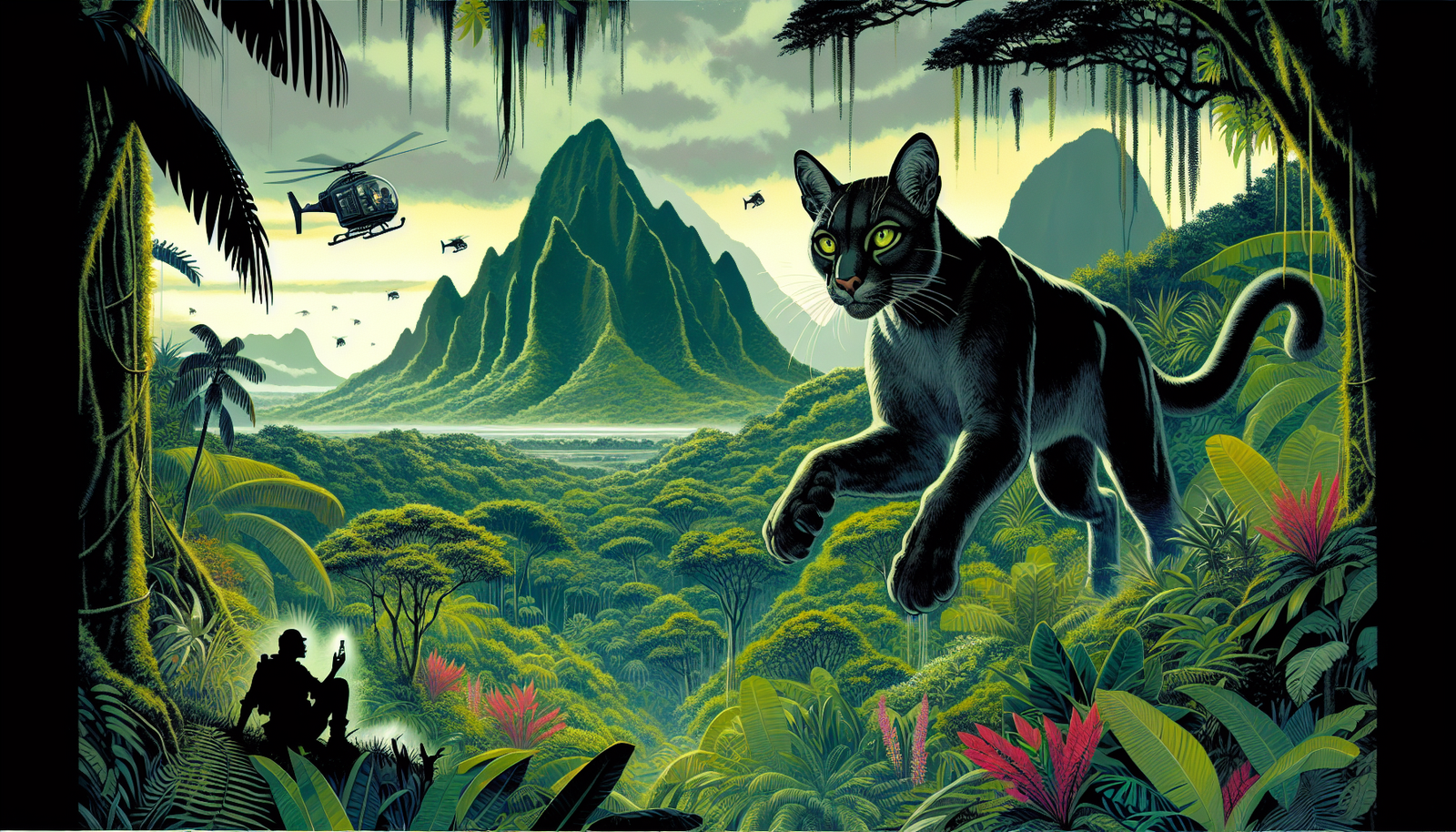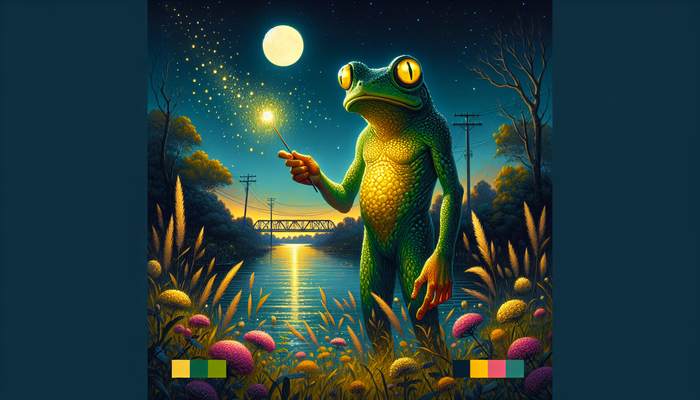Unraveling the Mystery of Hawaii's Elusive Big Cats

By Oliver Bennett, Cryptozoologist
Imagine a tropical paradise where mysterious big cats roam the lush landscapes, defying expectations and captivating the imagination. This is the reality that has gripped the Hawaiian islands for decades, as persistent reports of elusive felines have sparked intrigue and controversy among residents, visitors, and wildlife experts alike. As a researcher and scholar with a deep fascination for the unexplained, I have long been captivated by the enduring mystery of Hawaii's alleged big cats.
Hawaii, renowned for its unique and delicate ecosystem, has become the epicenter of an ongoing debate about the presence of these enigmatic predators. From the dense forests of Maui to the rugged slopes of the Big Island, eyewitness accounts and tantalizing clues have fueled speculation about the origins and impacts of these creatures on the islands' fragile wildlife. Join me as we embark on a journey to unravel the mystery of Hawaii's elusive big cats, exploring the legends, the ecological implications, and the tireless efforts to separate fact from fiction in this captivating tale.
The Legends of Hawaii's Big Cats
The Maui Mystery Cat
Our story begins on the enchanting island of Maui, where whispers of a mysterious feline presence first captured the public's imagination in the early 2000s. Residents of the Olinda area, nestled in the island's lush Upcountry region, began reporting sightings of a large, black, cat-like creature prowling the dense forests and misty hillsides. Described as being around 7 feet long, with a sleek, muscular build, piercing yellow-green eyes, and a distinctively flat face, the elusive animal quickly earned the moniker of the "Maui Mystery Cat."
As reports of the creature continued to surface, state wildlife officials launched an investigation into the perplexing sightings. Teams of biologists and trackers combed the area, uncovering intriguing pieces of evidence that seemed to support the presence of a large predator. Deep claw marks scarred the trunks of trees, suggesting the animal's impressive size and strength. The discovery of dead doves bearing peculiar bite marks hinted at the creature's hunting prowess. And perhaps most compelling of all were the large, 4-inch paw prints that appeared to be too substantial to belong to any known feline species native to the islands.
Despite the mounting evidence, the Maui Mystery Cat proved to be an elusive quarry. Traps were set, and infrared cameras were deployed, but the creature seemed to vanish into the dense foliage, leaving only tantalizing glimpses and unanswered questions in its wake. As the search efforts intensified, so too did the debate about the animal's true nature. Some speculated that it could be a large feral cat, while others suggested more exotic possibilities, such as a jaguar or leopard that had been illegally released or had escaped from captivity.
As the years passed, the Maui Mystery Cat remained a source of fascination and frustration for those who sought to unravel its secrets. Sightings continued to trickle in from various parts of the island, but conclusive proof of the creature's existence remained maddeningly out of reach. The case of the Maui Mystery Cat stands as a testament to the enduring allure of the unknown and the power of legend to capture our collective imagination.
The Big Island Wildcat Sightings
The mystery of Hawaii's elusive big cats took on a new dimension in recent years, as reports of a similar creature began to emerge from the rugged terrain of the Big Island. In August 2022, a resident of Holualoa, a small community nestled in the slopes above Kailua-Kona, reported a startling encounter with a large, cat-like animal while tending to his property. The eyewitness, who chose to remain anonymous, described the creature as being the size of a large dog, with a powerful, muscular build that set it apart from any feline he had ever seen.
The man's account of the sighting was as dramatic as it was perplexing. He claimed that upon spotting the animal, he retrieved his rifle and fired a warning shot, hoping to scare the creature away. To his astonishment, the cat-like beast displayed an incredible feat of agility, leaping an estimated 5-6 feet into the air and covering a distance of some 30 feet in a single bound. The eyewitness managed to capture a few blurry photographs of the animal and its large paw prints before it vanished into the dense undergrowth.
News of the sighting quickly spread, and the Hawaii Department of Land and Natural Resources (DLNR) launched an investigation into the intriguing report. Officials set up cameras and bait stations in the area, hoping to capture clearer images of the mysterious creature. However, their efforts yielded only photographs of pigs and small cats, leaving the identity of the larger animal shrouded in uncertainty.
In the weeks that followed, additional sightings began to trickle in from various locations across the Big Island, including Pualani Estates, Kawaihae, Kau, and Mountain View. These reports, however, lacked the photographic evidence that had accompanied the initial Holualoa sighting, making it difficult for the DLNR to investigate them further. The department acknowledged the challenges posed by the island's vast distances and rugged terrain, which made it unlikely that a single large predator could have traversed such expansive areas in a short period.
The mystery deepened in September 2022, when a staff member at the Manago Hotel in Captain Cook, just 5 miles from the original Holualoa sighting, reported seeing a large, cat-like creature on the property. The hotel's security cameras captured footage of the animal, but the grainy and inconclusive nature of the video only served to fuel further speculation. A visitor from California who was staying at the hotel corroborated the sighting, claiming to have seen what they believed to be a mountain lion.
As the DLNR and the Hawaii Department of Agriculture (DOA) continue their investigations into the Big Island wildcat sightings, the lack of clear photographic or video evidence has hampered their efforts to confirm the presence of a large, non-native predator. The DOA has emphasized the importance of cooperation from eyewitnesses in order to assess the credibility of the reports and to guide their ongoing search for answers.
The Big Island wildcat sightings have reignited the debate about the presence of elusive big cats in Hawaii, drawing parallels to the enduring mystery of the Maui Mystery Cat. As wildlife officials and the public alike grapple with the implications of these sightings, the quest for definitive proof continues, fueled by a mix of curiosity, concern, and the tantalizing possibility that a new chapter in Hawaii's natural history may be unfolding before our very eyes.
The Ecological Implications of Big Cats in Hawaii
Hawaii's Delicate Ecosystem
To fully grasp the potential impact of big cats on Hawaii's environment, it is essential to understand the unique and fragile nature of the islands' ecosystems. Isolated in the vast expanse of the Pacific Ocean, the Hawaiian archipelago has evolved over millions of years, giving rise to an extraordinary array of endemic species found nowhere else on Earth. From the melodious calls of the Hawaiian honeycreepers to the delicate beauty of the silversword plants, Hawaii's native flora and fauna have adapted to thrive in the absence of large predators, resulting in a delicate ecological balance that is easily disrupted by the introduction of non-native species.
The vulnerability of Hawaii's endemic species to invasive predators cannot be overstated. Having evolved in the absence of such threats, many of the islands' native birds, insects, and plants lack the natural defenses and adaptations necessary to withstand the onslaught of introduced predators. This vulnerability has already been tragically demonstrated by the devastating impact of feral cats on Hawaii's avian populations, with numerous endemic bird species driven to the brink of extinction or lost forever due to the relentless predation of these non-native felines.
Potential Threats Posed by Big Cats
The presence of big cats in Hawaii, whether they be escaped or illegally released pets or a previously unknown population, would pose a grave threat to the islands' already imperiled ecosystems. As apex predators, these large felines would occupy the top of the food chain, exerting a profound influence on the delicate balance of predator-prey relationships that have evolved over millennia.
One of the most immediate and dire consequences of big cats in Hawaii would be the predation of native wildlife. Species such as the nene (Hawaiian goose), the alala (Hawaiian crow), and the critically endangered Hawaiian monk seal would be particularly vulnerable to the hunting prowess of these powerful predators. The introduction of a new top predator could rapidly decimate populations of endemic species, many of which are already teetering on the brink of extinction due to habitat loss, invasive species, and other anthropogenic pressures.
In addition to the direct impact of predation, the presence of big cats could also disrupt the delicate balance of competition among the islands' existing predators. Hawaii's native predators, such as the pueo (Hawaiian short-eared owl) and the io (Hawaiian hawk), have evolved to fill specific niches within the ecosystem. The introduction of a larger, more dominant predator could upset this balance, leading to cascading effects throughout the food web as native predators are outcompeted or displaced.
The potential for disease transmission is another significant concern associated with the presence of big cats in Hawaii. As we have seen with the devastating impact of toxoplasmosis on native species, introduced predators can serve as vectors for pathogens that can have far-reaching and lethal consequences for the islands' wildlife. The introduction of novel diseases carried by big cats could further imperil already vulnerable populations, compounding the challenges faced by conservation efforts.
Finally, the presence of big cats in Hawaii would pose an undeniable risk to human safety. As large, powerful predators, these animals have the potential to cause serious injury or even death in the event of an encounter with humans. The fear and anxiety generated by the presence of such predators could have significant impacts on the quality of life for Hawaii's residents and visitors, as well as on the islands' economy, which is heavily dependent on tourism.
Lessons from the Impact of Feral Cats
The devastating impact of feral cats on Hawaii's native bird populations serves as a sobering reminder of the ecological havoc that can be wrought by introduced predators. Descended from domestic cats brought to the islands by European explorers, feral cat populations have exploded across the Hawaiian archipelago, with estimates ranging from hundreds of thousands to over a million individuals.
These opportunistic predators have proven to be a formidable threat to Hawaii's endemic birds, many of which have evolved in the absence of mammalian predators and lack the necessary defenses to withstand the onslaught of these non-native hunters. Feral cats have been implicated in the extinction of numerous endemic bird species and continue to pose a grave threat to the islands' remaining avian populations, including the critically endangered Hawaiian crow and the Hawaiian petrel.
In addition to the direct impact of predation, feral cats also serve as the primary host for the Toxoplasma gondii parasite, which can have lethal consequences for native wildlife. This insidious pathogen, which is spread through cat feces, has been linked to the deaths of Hawaiian monk seals, spinner dolphins, and several bird species. The presence of toxoplasmosis in Hawaii's ecosystems underscores the far-reaching and often unexpected consequences of introduced predators on the islands' delicate ecological balance.
The challenges posed by feral cat populations in Hawaii serve as a cautionary tale for the potential impact of big cats on the islands' ecosystems. The introduction of a larger, more formidable predator could have even more devastating consequences for native wildlife, compounding the already significant threats posed by feral cats and other invasive species.
As wildlife managers and conservationists grapple with the ongoing challenge of controlling feral cat populations, the lessons learned from these efforts can inform the response to the potential presence of big cats in Hawaii. The importance of early detection, rapid response, and sustained control efforts cannot be overstated when dealing with introduced predators in such a fragile and unique ecological setting.
The ecological implications of big cats in Hawaii are a stark reminder of the vulnerability of the islands' endemic species and the critical importance of preventing the introduction of non-native predators. As the search for answers continues in the mystery of Hawaii's elusive big cats, the potential consequences of their presence serve as a rallying cry for the urgent need to protect and preserve the irreplaceable natural heritage of the Hawaiian Islands.
Investigating the Mystery: Challenges and Strategies
Difficulties in Verifying Sightings
The quest to unravel the mystery of Hawaii's elusive big cats has been fraught with challenges, not least of which is the difficulty in verifying the numerous sightings reported by eyewitnesses. Despite the tantalizing accounts of large, cat-like creatures prowling the islands' forests and hillsides, the lack of clear photographic and video evidence has hampered efforts to conclusively confirm the presence of these enigmatic predators.
One of the primary obstacles in verifying sightings is the often fleeting and distant nature of the encounters. Many eyewitnesses report catching only brief glimpses of the alleged big cats, often in low light conditions or from a considerable distance. These factors make it difficult to capture clear, detailed images of the animals, leaving investigators with little more than blurry photographs and shaky video footage to work with.
The remote and rugged terrain of Hawaii's islands also poses significant challenges to the investigation of big cat sightings. The dense forests, steep hillsides, and vast lava fields that characterize much of the Hawaiian landscape provide ample cover for elusive predators to evade detection. The inaccessibility of many of these areas makes it difficult for wildlife officials and researchers to conduct thorough searches or to deploy monitoring equipment, such as motion-activated cameras, in strategic locations.
Another confounding factor in the verification of big cat sightings is the potential for misidentification. Hawaii is home to a diverse array of native and non-native species, some of which could be mistaken for larger, more exotic felines under certain conditions. Feral cats, in particular, have been suggested as a possible source of confusion, as their size and coloration can vary widely, and they are known to inhabit many of the same areas where big cat sightings have been reported.
The challenges inherent in verifying big cat sightings in Hawaii underscore the need for a multifaceted approach to the investigation of these enigmatic predators. While the pursuit of clear photographic and video evidence remains a top priority, the difficulties posed by the islands' terrain and the potential for misidentification necessitate the use of additional strategies and technologies to help unravel the mystery.
The Role of Citizen Science
One of the most promising avenues for advancing the investigation of Hawaii's elusive big cats is the engagement of the public through citizen science initiatives. By enlisting the help of residents and visitors alike in the search for evidence, wildlife officials and researchers can greatly expand their reach and increase the likelihood of capturing definitive proof of these enigmatic predators.
Citizen science has already played a crucial role in the ongoing investigation, with numerous sightings and reports of big cats being submitted by members of the public.
From Bigfoot to UFOs: Hangar 1 Publishing Has You Covered!
Explore Untold Stories: Venture into the world of UFOs, cryptids, Bigfoot, and beyond. Every story is a journey into the extraordinary.
Immersive Book Technology: Experience real videos, sights, and sounds within our books. Its not just reading; its an adventure.



























